Characterization and Evaluation of Properties of Cassava Starch/Poly(Vinyl Alcohol) Films for Food and Pharmaceutical Packaging Applications
| Received 09 Oct, 2024 |
Accepted 29 Nov, 2024 |
Published 30 Nov, 2024 |
Background and Objective: The increasing demand for plastics has generated environmental concerns ranging from terrestrial to aquatic pollution. This study investigates the properties of cassava starch/poly(vinyl alcohol) (PVA) films for potential applications in food and pharmaceutical coating. Materials and Methods: The study was conducted in a laboratory in Benin City, Nigeria. The materials included cassava starch, PVA and glycerol, all of analytical grade. Cassava starch/PVA films were prepared by solution casting method. The starch and PVA mixture were dispersed in water, heated and stirred under a magnetic stirrer for homogenization, followed by plasticization with glycerol. The viscous solution was cast and dried into films. The film thickness was measured for uniformity. Data from mechanical, thermal and biodegradation tests were analyzed using linear regression and ANOVA to assess significance and variable relationships. Results: The morphology and structure characteristics of the starch/PVA films suggest compatibility between the components resulting in uniform and smooth surfaces and tough and firmer films. In comparison to starch film, thermal stability was enhanced with a noticeable shift towards a higher temperature of maximum temperature of degradation observed for the starch/PVA films. Incorporation of PVA into starch markedly reduced the water vapour permeability of starch/PVA but compromised the soil burial biodegradation of starch; although starch/PVA films with 30% PVA attained 90% biodegradation in short-term biodegradation tests. Conclusion: The study demonstrated that cassava starch/PVA films show enhanced thermal stability, mechanical properties and reduced water vapor permeability, making them suitable for biodegradable applications.
| Copyright © 2024 Omoike et al. This is an open-access article distributed under the Creative Commons Attribution License, which permits unrestricted use, distribution, and reproduction in any medium, provided the original work is properly cited. |
INTRODUCTION
Advances in petroleum-based polymers have greatly benefited humanity, leading to their widespread use in various fields, including pharmaceutical applications, food packaging and agricultural materials1. However, it has become increasingly clear that the ecosystem is significantly disturbed and harmed by these non-degradable plastic materials. As a result, there is a growing interest in renewable and biodegradable polymers as packaging materials. Starch, a natural polymer, has been considered a promising candidate for biodegradable packaging applications due to its attractive combination of availability, price and performance2,3. However, starch-based materials have limitations due to their highly hydrophilic nature, which affects their mechanical properties and water resistance4.
By incorporating plasticizing agents such as water and/or polyhydroxyl alcohols, starch can be made thermoplastic (plasticized starch) through destructurization by the application of mechanical and thermal energy5. The effect of both humidity and plasticizer concentration on crystallinity, thermal and mechanical properties of starch is fairly well reported6,7. In order to improve mechanical properties and water resistance, starch has been modified by blending with synthetic8,9, natural polymers10,11 and by crosslinking12. One promising alternative blend is polyvinyl alcohol (PVA), a biodegradable polymer with advantages such as solubility in water, good mechanical properties and resistance to oxygen gas permeation13. The PVA has been widely used in various industries, including textile, paper and food packaging, despite its cost14.
This study examined the structure and morphology together with the mechanical and water vapour barrier properties of polymeric materials based on cassava starch and poly (vinyl alcohol) (PVA) blends to evaluate their potential in food and pharmaceutical applications.
MATERIALS AND METHODS
Study area and sites: This research took place in Benin City, Edo State, Nigeria, which is positioned at a Latitude of 6.34°N and a Longitude of 5.63°E. The city’s elevation is 88 m above sea level. With a population of over 2,125,058, Benin City is the largest urban area in Edo State.
Sample collection and analysis: Ten kilogram of cassava starch, poly (vinyl alcohol) (PVA) and glycerol of analytical grade were purchased from a chemical supply store in Benin City. All other chemicals and reagents used were of analytical grade. This study spanned from September, 2021 to July, 2023.
Preparation of cassava starch/PVA films: Cassava starch/PVA films were prepared using the method described by Patil et al.15. In a typical experiment, aqueous dispersion of starch was used with an aqueous solution of PVA under magnetic stirring for 60 min and then heated at 90°C for 30 min followed by the addition of glycerol as plasticizers. The mixture was kept at 80°C for 30 min and subsequently cast on the glass plate and then allowed to air-dry in an enclosed environment for 12 hrs and then dried at 60°C for 4 hrs. The thickness of the film obtained was measured at three different positions using a hand-held digital caliper.
Characterization
Scanning electron microscopy: The surface morphological features of the films were examined using a scanning electron microscope (Pheno ProX. Eindhoven, Netherlands) at a magnification resolution of 1500-2000 times and under an accelerating voltage of 10 kV. To facilitate this analysis, each film was sputter-coated with a thin layer of gold foil and then imaged using a focused beam of electrons. The resulting images were subsequently used for analysis.
X-ray diffraction: The crystalline structure of cassava starch/PVA films was characterized by X-ray diffraction (XRD) analysis. The XRD patterns were obtained using a Rigaku X-ray diffractometer (miniflex 600), operated at 40 kV and 50 mA, with Copper Kα radiation (wavelength = 1.544 A°).
Thermogravimetric analysis: The stability to thermal degradation of the test materials was determined by thermogravimetry using the Perkin-Elmer thermal analyzer TGA 4000 under nitrogen atmosphere and at a heating rate of 10°C/min in the 30-950°C temperature range.
Evaluation of properties
Tensile mechanical properties: The tensile properties of each film, including tensile strength (TS), percentage elongation at break (EB(%)) and tensile modulus, were evaluated using a universal tensile testing machine (TecQuipment) in accordance with standard test procedures16.
Water vapour permeability: The water vapour permeability (WVP) measurements were carried out using the ASTM E96 method as described by Bertuzzi et al.16. Test films were scaled on cups containing distilled water. The test cups were placed in a desiccator maintained at ambient temperature and 75% RH with saturated NaCl solution. Periodical weightings monitored the weight changes. The WVP was calculated from the slope (G) of a linear regression of weight loss versus time using the equation:
| (1) |
Where, x is the thickness of the film, A is the area of the exposed film and ΔP is the differential water vapour pressure across the film.
Biodegradation test: Short-term degradation of the test materials was carried out by the soil burial method described by Alshabanat17 using pot experiments. Test pieces of the films (3 cm×5 m) were buried in soil in plastic containers at a depth of 10 cm and kept moist by regular sprinkling of water and allowing excess water to drain through a hole at the bottom of the container. Weight loss of the test samples was measured at regular intervals of time for 8 weeks. The degree of soil burial degradation (DSBD) was obtained as the percentage weight loss of the test samples as shown in Eq. 2:
| (2) |
where, Wi is the original weight of the film and Wt is the weight of film after soil burial degradation.
Tools and equipment manufacturers: The instruments used in this study, such as the digital caliper, oven, analytical balance, desiccator and other equipment, were obtained from well-known manufacturers, including Hanna Instruments (Woonsocket, Rhode Island, USA), Thermo Fisher Scientific (Waltham, Massachusetts, USA) and Mettler Toledo (Columbus, Ohio, USA) among others.
Statistical analysis: The statistical analysis was carried out using the BMDP 2R software (version 7.0) for stepwise multiple regression. Data were presented as the mean of three replicate measurements. The findings of the study were considered statistically significant at p<0.0518,19.
RESULTS AND DISCUSSION
Scanning electron microscopy: It can be seen from the SEM micrographs that the coarse granular and porous structure that characterized the morphology of starch powder (Fig. 1a) disappeared in the micrographs of starch and starch/PVA films (Fig. 1b-c) that present uniform, smooth surfaces.
The apparent absence of zones of heterogeneous discontinuity in the micrograph of starch/PVA film suggests compatibility between starch and PVA components and is considered to result from the similarity in the functional groups present in the materials.
X-ray diffraction: The crystalline structure of starch/PVA film as determined from the X-ray diffraction patterns is presented in Fig. 2.
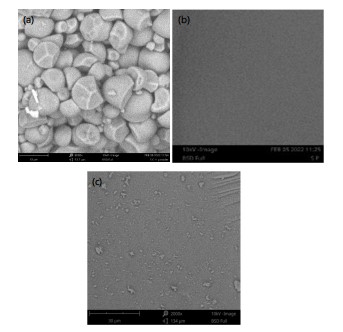
|
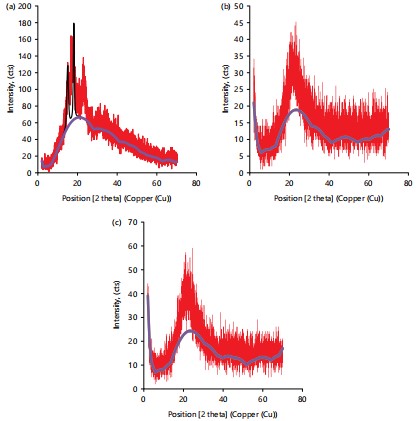
|
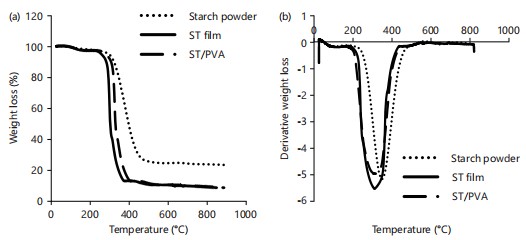
|
The result showed that the strong peak at 2 attributable to crystallites in granular starch (Fig. 2a) was markedly reduced in the diffractograph of starch and starch/PVA films. Disruption of molecular orderliness in the starch granules caused by granular swelling and gelatinization of starch20 would account for the observed reduction in the peak in starch (Fig. 2b). It would appear that incorporation of PVA into starch increased the crystallite peak at 2ϑ = 23.4 in comparison with starch granule and starch film (Fig. 2c). This may be explained in terms of intermolecular interaction between starch and PVA leading to firmer and tougher films21.
Thermal stability of films: Figure (3a-b) showed the thermogravimetric analysis (TGA) and derivative thermogravimetric analysis (DTG) curves of starch powder, starch film and starch/PVA film, respectively. Thermal stability of polymeric materials depends on the inherent characteristics of the sample as well as on the molecular interactions between the different macromolecules22. The chain cleavage or bond dissociation of the macromolecules takes place when the applied thermal energy exceeds the bond dissociation of the respective chemical bonds. The proportions of starch, PVA, different extent of H-bonding between the molecules and formation of crosslinks will affect the thermal stability of the test materials. The result in Fig. 3a indicates an initial weight loss at about 200°C in all the test samples which is attributed to loss of water and glycerol molecules.
The second stage in the degradation profile occurred between 200 and 380°C corresponding to the degradation of gelatinized starch and PVA. The derivative thermal analysis (DTA) curves of the test materials (Fig. 3b) show that the maximum degradation temperature is shifted from 336°C for starch film to 373°C for starch/PVA film. Intercomponent H-bonding between starch and PVA is considered to contribute to the enhanced thermal stability of starch/PVA material.
Tensile mechanical properties: During usage, packaging films are inevitably exposed to various forms of tensile stress. The ability of a film to withstand such stress is largely dependent on its structural composition and the strength of intermolecular interactions between its constituent components. The variations of the measured tensile mechanical properties; ultimate tensile strength, elongation at break and modulus with composition of test materials are shown in Fig. 4.
The result indicates that marked increase in the measured properties accompanied increase in the amount of PVA in the test material. Compared to unmodified starch film, 4-fold increase in ultimate tensile strength, 2-fold increase in the values of elongation at break and modulus accompanied the incorporation of PVA into starch. The results also indicate that a 3-fold increase in the amount of PVA in the test materials was associated with an increase of about the same order of magnitude, 3-fold in the value of ultimate tensile strength and to only about 1.4 fold increase and 1.5-fold increase in the values of elongation at break and modulus, respectively (Fig. 4a-b).
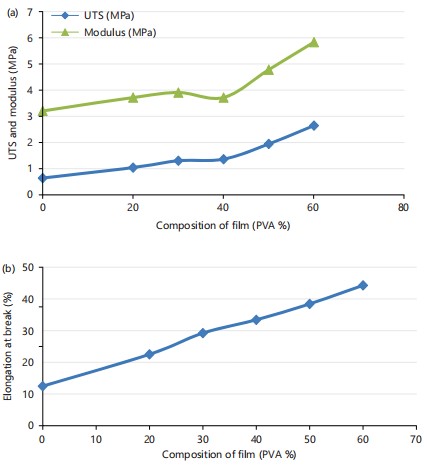
|
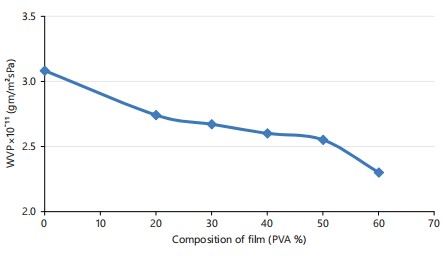
|
Water vapour permeability: The result of WVP of the films were presented in Fig. 5 as a function of composition of test materials (PVA(%)).
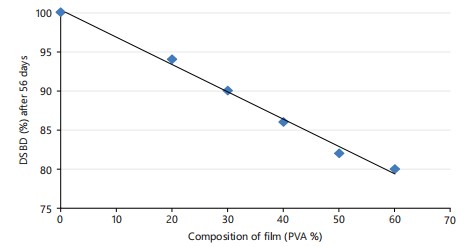
|
| Table 1: | Degree of soil burial biodegradability (%) of cassava starch/PVA films | |||
| Composition of film (PVA (%)) | 7 days | 14 days | 21 days | 28 days | 35 days | 42 days | 49 days | 56 days |
| 0 | 42 | 59 | 69 | 79 | 87 | 91 | 94 | 100 |
| 20 | 41 | 57 | 65 | 75 | 81 | 85 | 90 | 94 |
| 30 | 39 | 56 | 66 | 77 | 80 | 82 | 86 | 90 |
| 40 | 34 | 56 | 64 | 67 | 73 | 79 | 84 | 86 |
| 50 | 34 | 54 | 63 | 68 | 75 | 76 | 81 | 82 |
| 60 | 33 | 54 | 61 | 64 | 70 | 75 | 79 | 80 |
The results showed that there was a marked reduction of up to 58% in water vapour permeability accompanied incorporation of PVA (60%) into cassava starch. The marked reductions in water vapour permeability have implication for the potential application of starch/PVA films in food packaging. Reduction in the transfer of moisture can protect packaged products from the environment and help maintain its quality for longer storage period. The results also indicate that a 3-fold increase in the amount of PVA in the test material resulted in moderate reduction of about 16% in water vapour permeability and suggest that significant modifications in the moisture vapour permeability of cassava starch may beattained with moderate (<20%) addition of synthetic PVA. This is important in the biodegradability of starch/PVA film if utilized in single-application food packaging purposes. The values of WVP reported in this study are about the same order of magnitude but somewhat lower than the values reported for zein films17.
Biodegradation of films: The degree of soil burial degradation (DSBD) was obtained as the percentage weight loss of the test samples as shown in Fig. 6 as a function of the composition (PVA(%)) of the test materials. The results show the degree of soil burial degradation of the test films as a function of duration of burial test and composition (PVA(%)) of the test materials (Table 1).
The results show the expected increase in recalcitrance to soil burial degradation with increase in the proportion of PVA in the test material. The observed effect of PVA on the structure’s thermal stability, tensile mechanical properties and water vapour permeability are consistent with the results of recalcitrance of starch/PVA films to soil burial degradation. The DBSD (%) of the test samples after 56 days (end of the short-term tests) is given in Fig. 6. It is pertinent to note that near quantitative degradation (%) was obtained for starch/PVA films with (wt(%)) PVA. As noted from water vapour permeability tests, significant enhancement in biodegradability may be achieved with the moderate addition of PVA to cassava. This result is significant for the application of cassava starch/PVA films in biodegradable packaging.
CONCLUSION
Cassava starch/PVA films exhibit enhanced thermal stability, mechanical strength and water vapor barrier properties, especially with 60% PVA. The strong intermolecular interactions between starch and PVA account for these improvements. Although biodegradability slightly decreases with higher PVA content, the films still show promising degradation rates. Future research should focus on optimizing the balance between biodegradability and barrier properties and further exploring their potential for commercial use in food and pharmaceutical packaging.
SIGNIFICANCE STATEMENT
This research on cassava starch/PVA films for food and pharmaceutical applications is significant because it addresses the growing demand for sustainable packaging materials, explores the potential of cassava starch as a biodegradable resource and investigates the enhancement of its properties through blending with PVA. By developing a sustainable and eco-friendly packaging solution, this study contributes to reducing environmental impact, promoting a circular economy and offering a promising alternative to synthetic materials. The findings of this research will provide valuable insights into the properties and applications of cassava starch/PVA films, informing future research and industrial applications in the food and pharmaceutical industries.
REFERENCES
- Phattarateera, S., L. Xin, C. Amphong, V. Limsamran and P. Threepopnatkul, 2023. Comparative studies of starch blends on the properties of PVA films. Carbohydr. Polym. Technol. Appl., 6.
- Zhang, Y., Z. Liu and J. Han, 2008. Starch-Based Edible Films. In: Environmentally Compatible Food Packaging, Chiellini, E. (Ed.), Woodhead Publishing, Cambridgeshire, United Kingdom, ISBN: 9781845691943, pp: 108-136.
- Chivrac, F., H. Angellier-Coussy, V. Guillard, E. Pollet and L. Avérous, 2010. How does water diffuse in starch/montmorillonite nano-biocomposite materials? Carbohydr. Polym., 82: 128-135.
- Ribba, L., N.L. Garcia, N. D’Accorso and S. Goyanes, 2017. Disadvantages of Starch-Based Materials, Feasible Alternatives in Order to Overcome These Limitations. In: Starch-Based Materials in Food Packaging: Processing, Characterization and Applications, Villar, M.A., S.E. Barbosa, M.A. García, L.A. Castillo and O.V. López (Eds.), Academic Press, Cambridge, Massachusetts, ISBN: 9780128094396, pp: 37-76.
- Surendren, A., A.K. Mohanty, Q. Liu and M. Misra, 2022. A review of biodegradable thermoplastic starches, their blends and composites: Recent developments and opportunities for single-use plastic packaging alternatives. Green Chem., 24: 8606-8636.
- Butler, M.F. and R.E. Cameron, 2000. A study of the molecular relaxations in solid starch using dielectric spectroscopy. Polymer, 41: 2249-2263.
- Moates, G.K., T.R. Noel, R. Parker and S.G. Ring, 2001. Dynamic mechanical and dielectric characterisation of amylose-glycerol films. Carbohydr. Polym., 44: 247-253.
- Gómez-Aldapa, C.A., G. Velazquez, M.C. Gutierrez, E. Rangel-Vargas, J. Castro-Rosas and R.Y. Aguirre-Loredo, 2020. Effect of polyvinyl alcohol on the physicochemical properties of biodegradable starch films. Mater. Chem. Phys., 239.
- Sharma, N., L.P. Chang, Y.L. Chu, H. Ismail, U.S. Ishiaku and Z.A.M. Ishak, 2001. A study on the effect of pro-oxidant on the thermo-oxidative degradation behaviour of sago starch filled polyethylene. Polym. Degrad. Stability, 71: 381-393.
- de Carvalhoa, A.J.F., A.A.S Curvelo and J.A.M. Agnelli, 2001. A first insight on composites of thermoplastic starch and kaolin. Carbohydr. Polym., 45: 189-194.
- Fishman, M.L., D.R. Coffin, R.P. Konstance and C.I. Onwulata, 2000. Extrusion of pectin/starch blends plasticized with glycerol. Carbohydr. Polym., 41: 317-325.
- Shah, N., R.K. Mewada and T. Mehta, 2016. Crosslinking of starch and its effect on viscosity behaviour. Rev. Chem. Eng., 32: 265-270.
- Kumar, A., A. Sood and S.S. Han, 2022. Poly (vinyl alcohol)-alginate as potential matrix for various applications: A focused review. Carbohydr. Polym., 277.
- Jayarathna, S., M. Andersson and R. Andersson, 2022. Recent advances in starch-based blends and composites for bioplastics applications. Polymers, 14. https://doi.org/10.3390/polym14214557
- Patil, S., A.K. Bharimalla, A. Mahapatra, J. Dhakane-Lad and A. Arputharaj et al., 2021. Effect of polymer blending on mechanical and barrier properties of starch-polyvinyl alcohol based biodegradable composite films. Food Biosci., 44.
- Bertuzzi, M.A., E.F.C. Vidaurre, M. Armada and J.C. Gottifredi, 2007. Water vapor permeability of edible starch based films. J. Food Eng., 80: 972-978.
- Alshabanat, M., 2019. Morphological, thermal, and biodegradation properties of LLDPE/treated date palm waste composite buried in a soil environment. J. Saudi Chem. Soc., 23: 355-364.
- Ozoh, C., C. Imoisi and J.U. Iyasele, 2024. Effect of pH and duration of fermentation on the sensory, physicochemical and proximate characteristics of garri. Trends Appl. Sci. Res., 19: 156-169.
- Imoisi, C. and J.U. Iyasele, 2024. Investigation of heating time effects on viscosity profiles of cassava flour and citrus flour blends. Asian J. Emerging Res., 6: 22-30.
- Schmiele, M., U.M. Sampaio and M.T.P.S. Clerici, 2019. Basic Principles: Composition and Properties of Starch. In: Starches for Food Application: Chemical, Technological and Health Properties, Clerici, M.T.P.S. and M. Schmiele (Eds.), Academic Press, Cambridge, Massachusetts, ISBN: 9780128094402, pp: 1-22.
- Yurong, G. and L. Dapeng, 2020. Preparation and characterization of corn starch/PVA/glycerol composite films incorporated with ε-polylysine as a novel antimicrobial packaging material. e-Polymers, 20: 154-161.
- Ray, D., P. Roy, S. Sengupta, S.P. Sengupta, A.K. Mohanty and M. Misra, 2009. A study of dynamic mechanical and thermal behavior of starch/poly(vinylalcohol) based films. J. Polym. Environ., 17: 49-55
How to Cite this paper?
APA-7 Style
Omoike,
B.A., Okieimen,
F.E., Imoisi,
C., Abubakar,
M.A. (2024). Characterization and Evaluation of Properties of Cassava Starch/Poly(Vinyl Alcohol) Films for Food and Pharmaceutical Packaging Applications. Singapore Journal of Scientific Research, 14(1), 34-42. https://doi.org/10.3923/sjsr.2024.34.42
ACS Style
Omoike,
B.A.; Okieimen,
F.E.; Imoisi,
C.; Abubakar,
M.A. Characterization and Evaluation of Properties of Cassava Starch/Poly(Vinyl Alcohol) Films for Food and Pharmaceutical Packaging Applications. Singapore J. Sci. Res 2024, 14, 34-42. https://doi.org/10.3923/sjsr.2024.34.42
AMA Style
Omoike
BA, Okieimen
FE, Imoisi
C, Abubakar
MA. Characterization and Evaluation of Properties of Cassava Starch/Poly(Vinyl Alcohol) Films for Food and Pharmaceutical Packaging Applications. Singapore Journal of Scientific Research. 2024; 14(1): 34-42. https://doi.org/10.3923/sjsr.2024.34.42
Chicago/Turabian Style
Omoike, Bright, Ayemwenre, Felix Ebhodaghe Okieimen, Chinyere Imoisi, and Muhammad Aminu Abubakar.
2024. "Characterization and Evaluation of Properties of Cassava Starch/Poly(Vinyl Alcohol) Films for Food and Pharmaceutical Packaging Applications" Singapore Journal of Scientific Research 14, no. 1: 34-42. https://doi.org/10.3923/sjsr.2024.34.42

This work is licensed under a Creative Commons Attribution 4.0 International License.



